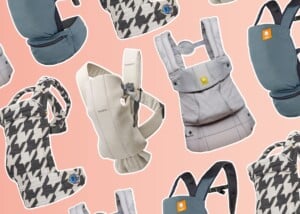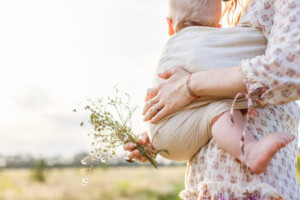Babywearing has become mainstream within Western cultures over the past decade. I cannot walk down the street without seeing at least one woman carrying her baby! And every time I see it, there is a happy baby somewhere in amongst all the fabric. We know that carrying babies tends to keep them happy (I mean, who wouldn’t want to be held and cuddled 24/7?!), yet babywearing’s benefits on breastfeeding often go unmentioned. Here are the top five ways that babywearing can help you breastfeed!
The Top 5 Ways Babywearing Can Help You Breastfeed
1. Babywearing Helps Facilitate the Important Act of Hanging Out with Your Baby
I know this sounds so simple and annoyingly obvious to some! Think back to the early days of motherhood, though . . . how many of us actually took the time just to hang out? Taking the time to just “BE” with your baby can mean the difference between breastfeeding getting off to an awesome start . . . or not. By taking the time to hang out with your baby quietly, you are putting yourself in the position to observe your baby’s early feeding cues so you can latch them on more easily BEFORE they are crying.
Both mother and baby tend to be much calmer when just hanging out together, and I will often tell new mothers . . . “Just let your baby hang out with your boobs 24/7!” While this might sound weird, it’s precisely what you and your baby need. By having a baby carrier, you can do this without sitting on your couch or in your bed.
2. Babies Who Are Held Tend to Be Babies Who Are Settled
Settled babies latch on easier and are much more likely to be calm when trying to get them onto the breast. If you try to latch your baby on while they are crying or starting to get upset, you will probably find it a lot more challenging. I know how cranky I get when I’m hungry . . . imagine that feeling combined with the inability actually to say, “I’m hungry! I have a wet diaper, and I’m exhausted!” Babies who are held frequently and cuddled 24/7 tend to just be happier. This is a great state for your baby to be in when trying to latch well in the early days.
3. It’s a Great Way to Be Skin-To-Skin With Your Baby Without Sitting or Lying Down
Cook some food, pick up your toddler’s toys . . . all while being skin-to-skin. This helps calm and comfort your baby and helps get breastfeeding off to the best start. We all know about skin-to-skin with a newborn, but it can also help calm an older baby or toddler who needs to be settled before they latch on. Skin-to-skin can also help when your baby is sick, teething, or just plain exhausted.
4. You Can Breastfeed Your Baby While They Are in an Upright Position, Encouraging the Best Latch Possible
Have you heard of the “koala” hold? This is the breastfeeding position where you hold your baby upright while feeding. Babies sitting upright often open their mouths wider and lift their faces upwards, which can help get the best latch possible. They can also move their head around easily in this position and hone their instincts to self-attach. Doing this in a baby carrier gives you another way of trying the “koala hold,” and babies usually love it!
5. Babywearing Allows You to Breastfeed While in Motion
I remember a friend who could only breastfeed her baby for the first few months after she was born while walking around! For some reason, her baby would not breastfeed unless she was moving around. The baby carrier was crucial in helping my friend do this without going insane or losing her arm from a lack of blood flow. Some babies prefer to breastfeed while being rocked or carried, and the baby carrier is a great way to do this without getting arm and neck pains.
*You must ensure you have help and guidance for safe babywearing. All baby carriers come with instructions that you and your baby must follow to ensure your safety. Make sure your baby carrier is compatible with breastfeeding before you purchase it, as not all are.




























